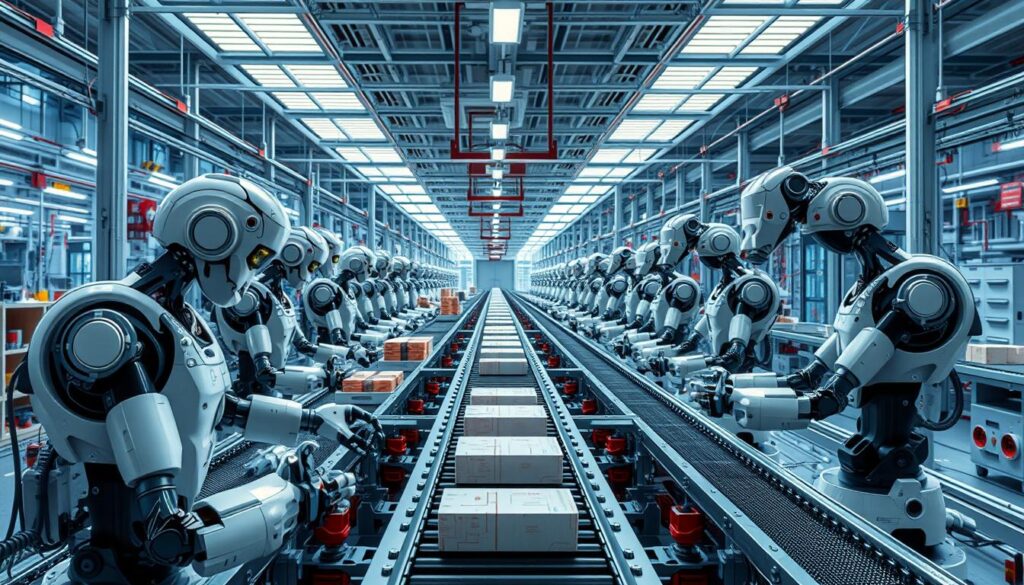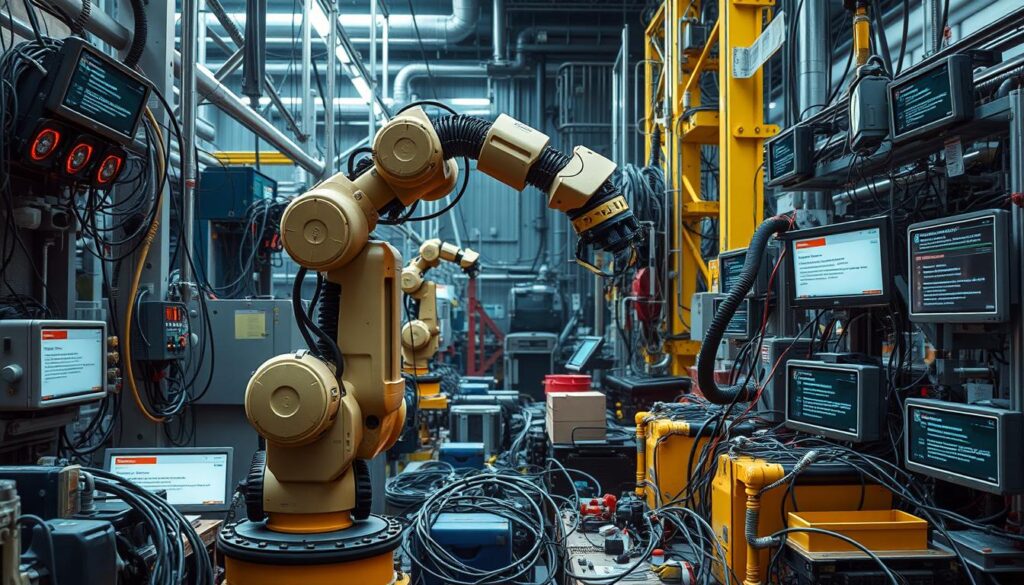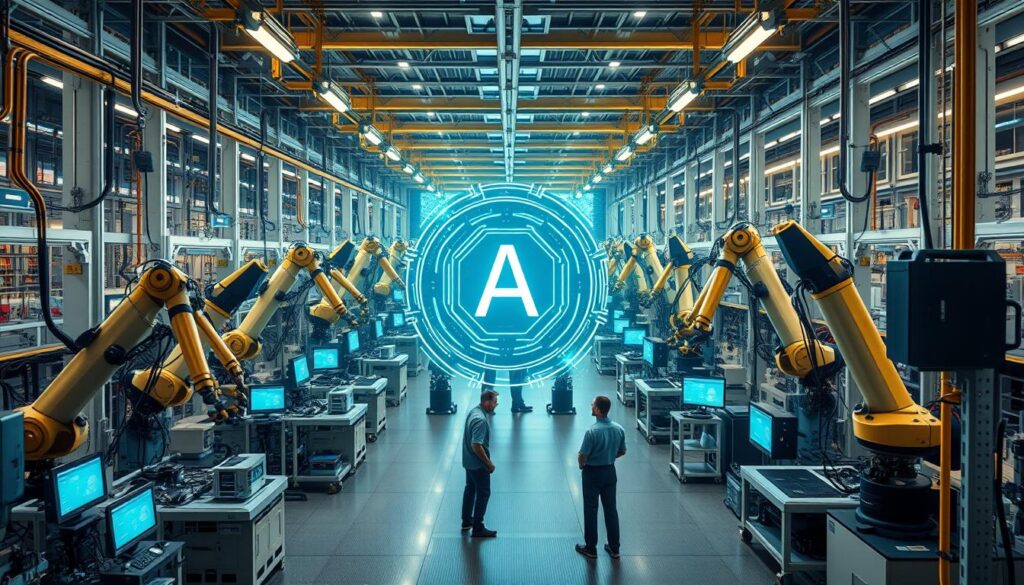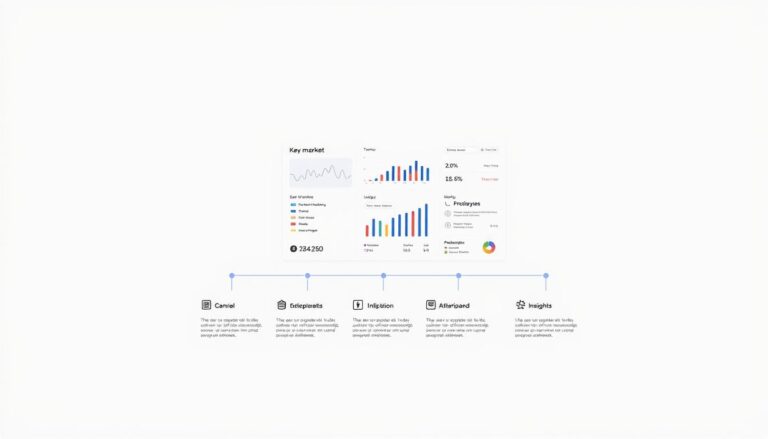In the modern marketplace, manufacturers are always looking for ways to improve. Adding artificial intelligence in manufacturing is a key strategy. AI agents help streamline operations and introduce smart manufacturing.
This isn’t about the future; it’s happening now. With a virtual assistant for the manufacturing industry, companies enjoy less downtime and better quality control. This changes how factories work, making them smarter.
In 2022, the AI market in manufacturing hit roughly USD 3.8 billion. Experts believe it will grow to USD 68.36 billion by 2032. This shows a huge annual growth rate of 33.5% from 2023 to 2032. AI is set to change manufacturing with its smart technology.
Key Takeaways
- AI agents significantly reduce operational costs and waste in manufacturing.
- Integration of AI agents leads to streamlined workflows and optimized processes.
- Real-time data analytics and decision-making are enhanced by AI technologies.
- The projected growth in the AI manufacturing market indicative of its transformative impact.
- Adaptation of sophisticated AI agents is crucial for the future of smart manufacturing.
- Machine learning applications in quality control are elevating standards in production.
Understanding AI Agents in Manufacturing
The use of AI in manufacturing opens up a new era. It’s led by cognitive technology for smart factories and methods meant for intelligent agents for production optimization. These tools boost efficiency and create forward-thinking production environments.
Definition and Key Components
An ai agent for manufacturing is made to act on its own, thinking and analyzing like humans. It can go through big amounts of data. This helps it learn and improve manufacturing processes. Key parts of it include:
- Input: Data collection in real time through sensors.
- Brain: It has profiling, memory, knowing, and planning systems.
- Action: It does tasks using automatic systems and robots.
This setup changes old factories into smart factories. They are filled with cognitive technology that makes production better.
Benefits of AI Agents
Using ai agents for manufacturing makes production quicker, reduces costs, and betters product quality. The main benefits include:
- Quality Control: Better monitoring greatly cuts down on defects.
- Predictive Maintenance: AI finds problems before they happen, lowering downtime.
- Supply Chain Optimization: Smart forecasting and stock management make operations more cost-effective.
- Sustainability: It uses materials and energy efficiently, reducing harm to the environment.
Moreover, taking up these technologies puts companies at innovation’s leading edge. This advantage is crucial in the fast-changing manufacturing world.
| Feature | Impact | Statistics |
|---|---|---|
| Predictive Maintenance | Reduced Downtime | Up to 50% decrease in unplanned downtime |
| Quality Control | Lower Defect Rates | 20% reduction in defects |
| Supply Chain Management | Cost Efficiency | Improved delivery accuracy and lower inventory costs |
| Sustainability | Waste Reduction | Up to 30% reduction in material waste |
The table shows clear benefits from using ai agents for manufacturing in the industry. It points to the big plus sides in efficiency and sustainability that these technologies offer.
How AI Agents Enhance Production Efficiency
In today’s factories, automated agents for factory operations are changing the game. They make manufacturing faster and smarter. These AI agents boost efficiency and make things run smoother. They put smart automation at the heart of production, leading to better operations.
Revolutionizing Manufacturing with AI agents shows how these tech tools speed up production. They also make manufacturing systems more resilient and flexible. With machine learning for industrial processes on the rise, factories are becoming smarter and more self-sufficient.

Streamlining Processes with Automation
Automated agents help in many parts of factory work, like assembly lines and supply chains. They automate simple tasks, improve workflows, and cut down on mistakes. Tools like the AI-driven Connected Worker Platform, Augmentir, improve efficiency, product quality, and worker safety.
Reducing Downtime and Waste
Using automated agents in factories is key for predictive maintenance. They use machine learning to foresee machine issues before they happen. This ensures maintenance is prompt and effective. It leads to less downtime and longer machine life, cutting waste and costs. Adding smart models like Multi-Agent Reinforcement Learning (MARL) lets these systems make complex decisions.
Partnerships with big names in the industry have led to new benchmarks in efficiency. Support from the National Science Foundation has shown these efforts can enhance overall processes. This includes better use of energy and improved waste management.
As industries tackle worker shortages and complicated supply chains, automated agents for factory operations are more crucial than ever. By using these advanced tech tools, manufacturers stay competitive. They ensure their operations are sustainable and highly effective.
Real-Time Data Analysis and Decision Making
AI agents are changing how factories work, leading to a move towards data-driven decision-making. These agents make the most of real-time data analysis to enhance operations and foresee future trends.
Importance of Real-Time Data
Real-time data analysis is key in fast-moving manufacturing settings. It helps make quick decisions. By using data from IoT devices and sensors, AI agents let factories quickly adjust to new operational conditions.
This means less downtime, more productivity, and consistent quality in making products.
AI Algorithms for Predictive Analytics
Predictive analytics let AI agents guess problems before they happen. This lets factories take steps early to save time and resources. For example, knowing when machines might break down means they can be fixed before causing big issues.
Let’s look at what advanced predictive models can do in AI agents:
| Feature | Description | Impact on Manufacturing |
|---|---|---|
| Data Processing | Handles real-time data streams, providing instant insights. | Enables fast and effective decision-making processes. |
| Customizable Dashboards | Allows users to create and modify data visualizations that best suit their needs. | Improves monitoring and control of production metrics. |
| Advanced Analytics | Leverages machine learning and NLP to understand complex patterns and predict outcomes. | Enhances quality control and reduces waste due to precision in processes. |
This new way does not just help factories run better. It also moves them towards strong, predictive analytics-focused strategies. This reduces risks and makes decisions more accurate. As factories become smarter, the need for AI in analyzing data and guiding decisions grows. It’s crucial for the future of manufacturing.
Integrating AI Agents into Existing Manufacturing Systems
Integrating AI into manufacturing is about making sure it fits well with existing tech. This helps manufacturing companies boost their efficiency by using AI smartly. It makes operations smoother and updates systems to today’s needs for precision and flexibility.
Compatibility with Current Technologies
It’s important to check if new AI can work with what’s already there. Making sure AI fits right in is key for it to work well in the system. This means checking and updating machines and software so everything runs smoothly without stopping what’s already going on.
Steps for Successful Integration
- Initial System Review: Look at how things are done now to figure out where to add AI and see what needs changing.
- Selection of Suitable AI Agents: Pick the AI tools, like robots or learning systems, that meet the factory’s needs.
- Integration Planning: Plan how to add AI, including schedules, resources, and who needs to be involved.
- Testing and Deployment: Test the AI to make sure it works with the current setup. Roll it out slowly to avoid problems.
- Continuous Monitoring and Optimization: Keep an eye on the AI after putting it in to make sure it gets better over time.
By caring about tech fit and planning well, factories can do better and be more inventive. Adding AI carefully into what’s already there not only improves making things but also prepares companies for new tech and market changes.
Case Studies: Successful Implementations
Exploring AI’s role in manufacturing reveals its huge impact. Thanks to successful AI implementations, it’s clear that AI boosts both productivity and efficiency today. The industry’s growth, powered by AI, is captured in many case studies.
Company A: Increased Output
Company A saw a big boost in production after bringing AI into their process. They’ve kept their high quality while doing more. They also cut downtime by predicting when machines would need repairs.
This success story illustrates the advantage of using smart tech in manufacturing. McKinsey reports that firms using AI and digital tech see higher profits. This shows the real value of AI innovation.
Company B: Cost Reductions
Company B used AI to slash costs. They improved their planning and made their supply chain more efficient with AI. This cut down waste.
ABI Research found that most manufacturers invest in AI to get better and more efficient. Company B’s story proves that AI can greatly lower costs and improve operations. This shows why it’s crucial to use AI to compete in today’s fast-changing manufacturing world.
These examples highlight the clear advantages and necessary strategic shift towards AI in manufacturing. It’s a key move to stay ahead.
Challenges and Limitations of AI in Manufacturing
Artificial intelligence (AI) has greatly changed industries. However, using AI in manufacturing comes with difficulties. Some big challenges include high costs and the need for skilled workers. Businesses must understand these obstacles and find ways to overcome them to use intelligent manufacturing fully.

Initial Investment and Operational Costs
Bringing AI into manufacturing needs a lot of money at first for tech, infrastructure, and learning. Keeping and updating AI systems also costs more. This discourages even innovative companies.
Skill Gaps in Workforce
For AI in manufacturing to work well, skilled workers are necessary. But there’s a big gap in skills that slows down the use of smart manufacturing systems. Companies need to train their people to use AI tools properly.
| Challenge | Percentage of Affected Manufacturers | Potential Impact |
|---|---|---|
| Inadequate Data Quality | 57% | Impedes AI use-case development |
| Weak Data Integration | 54% | Challenges in AI application continuity |
| Poor Data Governance | 47% | Limits effective data utilization |
Companies need to be ready and act to deal with these issues. Coming up with ways to fill the skill gap and planning for AI costs can mean better AI use. Being able to deal with these problems is key to making the most of AI in manufacturing.
Future Trends in AI for Manufacturing
The evolving landscape of artificial intelligence (AI) in manufacturing consistently reinforces how technology can substantially elevate operational efficiency and strategic decision-making. Particularly, two areas stand out in their potential to reshape the industry: machine learning advancements and the integration of the Internet of Things (IoT). Both elements will significantly revolutionize the way manufacturing workflows and management operate.
With AI future trends leaning heavily towards an increased reliance on data-driven automation, manufacturers are poised to witness unprecedented improvements in both productivity and quality. This transition is not confined to mere speculation but is supported by robust data indicating AI’s growing infiltration into the sector. According to a Deloitte report, manufacturing leads in data creation, which forms the backbone for sophisticated AI applications.
Advancements in Machine Learning
At the forefront of these transformative trends are machine learning advancements. Data from General Motors and Danone illustrate practical gains. For instance, General Motors developed a machine learning model that conceived a seatbelt design vastly superior to its predecessors.
Danone, on the other hand, saw a significant reduction in forecast errors and improved demand forecasting. This highlights the potent applications of this technology in operational settings.
Impact of the Internet of Things (IoT)
The integration of IoT in manufacturing compounds these advancements by enriching connected devices with real-time data retrieval and analysis capabilities. For instance, BMW and Volkswagen harness AI through automated guided vehicles and AI-enhanced assembly lines, respectively. These implementations not only clarify the utility of IoT devices but also preview an era where digital synchronicity becomes a manufacturing staple.
This predictive capacity is anticipated to grow, with VentureBeat revealing that 66% of manufacturers are integrating AI at an operational level, fundamentally altering approaches to maintenance and quality control. The cumulative effect is a proactive, instead of reactive, methodology to managing workflows and production environments.
IoT in manufacturing does not only support real-time tracking and adjustments but also enables a profound ecosystem interconnectivity. This helps anticipate needs and streamline responses. The allure of predictive efficiency sees 89% of companies planning AI incorporations within their operational networks soon. This ensures sustained competitive edges.
As AI future trends continue to unfold, the amalgamation of machine learning advancements and IoT utilities cements the foundation for a smarter, more resilient manufacturing sector. It’s ready to handle the complexities of tomorrow’s market demands.
| AI Application | Impact | % of Firms Reporting Positive Outcomes |
|---|---|---|
| Generative AI | Enhanced decision-making | 26% |
| AI in Supply Chain Management | Reduced forecast errors by 50% | N/A |
| Predictive Maintenance | Improved maintenance schedules | Flagship cases in sector |
Conclusion: The Importance of Adopting AI Agents
The importance of AI agents in manufacturing is clear. It’s not a passing trend, but a major move towards changing the industry. The AI in manufacturing market is expected to reach $20.8 billion by 2028. This shows how vital these smart systems are for companies wanting to stay ahead.
Yet, less than 60% of manufacturers plan to spend more on AI by 2024. This shows we need to prove how AI benefits manufacturing processes clearly.
Strategic Advantages for Manufacturers
Using AI agents brings big improvements. For example, there’s a 10% drop in too much inventory. There’s also a 40% fall in manual reporting and a 25% reduction in the time it takes to convert leads. These benefits show why using AI is a smart move. It helps shift resources from old methods to new, growth-driving projects.
Manufacturers create about 1,812 petabytes of data a year. AI helps use this data better. It boosts productivity, improves quality control, and makes supply chains work better.
The Path Forward for Manufacturing Industry
The future is all about Industry 4.0. This journey from mechanical tools to sophisticated AI shows how the sector can reinvent itself. The variety of AI agents—reactive, deliberative, and hybrid—is growing. This helps make manufacturing more efficient, flexible, and well-organized.
These advances are not small. They are key, showing how essential AI agents are in manufacturing. They help the industry stay competitive and lead in innovation and growth.



